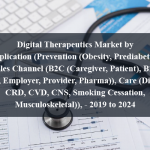OVERVIEW
The Wearable Injectors Market is projected to grow significantly from USD 6.8 billion in 2024 to an estimated USD 14.2 billion by 2029, reflecting a CAGR of 16.2% during the forecast period. Wearable injectors are advanced medical devices designed to deliver large-volume and long-duration injections of medications, typically for chronic diseases such as diabetes, cancer, and autoimmune disorders. These devices provide patients with a convenient and less invasive option for drug delivery, improving adherence and outcomes. The increasing prevalence of chronic diseases, advancements in wearable injector technology, and the growing demand for patient-centric drug delivery solutions are driving the market’s growth.
The market’s expansion is also supported by rising healthcare expenditure, increased adoption of biologics and biosimilars, and the integration of advanced technologies such as smart sensors and connectivity features in wearable injectors. However, challenges such as high costs of advanced wearable injectors, stringent regulatory requirements, and the complexity of ensuring accurate and safe drug delivery need to be addressed to sustain market growth.
Geographically, North America and Europe dominate the wearable injectors market due to their advanced healthcare infrastructure, significant investments in healthcare, and high adoption rates of innovative drug delivery technologies. The Asia Pacific region is also expected to witness substantial growth, driven by increasing healthcare expenditure, growing awareness of patient-centric healthcare solutions, and the expanding pharmaceutical sector.
Market Dynamics
Drivers:
The primary driver of the Wearable Injectors Market is the increasing prevalence of chronic diseases. Chronic conditions such as diabetes, cancer, and autoimmune disorders require frequent and long-term medication administration. Wearable injectors offer a convenient and less invasive solution for delivering these medications, enabling patients to manage their conditions more effectively. The rising incidence of chronic diseases is driving the demand for wearable injectors that can deliver large volumes of medication over extended periods, improving patient adherence and outcomes. Additionally, advancements in wearable injector technology, such as the development of devices with smart sensors and connectivity features, are enhancing the functionality and reliability of these devices, contributing to market growth.
Another significant driver is the growing demand for patient-centric drug delivery solutions. Patients and healthcare providers are increasingly recognizing the benefits of wearable injectors, which include improved convenience, reduced pain, and the ability to administer medications at home. Wearable injectors enable patients to maintain their daily activities while receiving necessary treatments, reducing the need for frequent hospital visits. The integration of advanced technologies, such as smart sensors and connectivity features, is further enhancing the capabilities of wearable injectors, enabling real-time monitoring, data collection, and personalized treatment plans. The rising preference for patient-centric drug delivery solutions and the continuous advancements in wearable injector technology are driving the growth of the wearable injectors market.
Key Opportunities
The Wearable Injectors Market presents numerous opportunities for growth and innovation, particularly in the development and integration of advanced technologies. One prominent opportunity lies in the increasing use of smart sensors and connectivity features in wearable injectors. Smart sensors can monitor and adjust medication delivery in real-time, ensuring accurate and safe administration. The integration of connectivity features with traditional wearable injectors is expected to drive market growth by providing more reliable and efficient drug delivery solutions. Additionally, connected wearable injectors can facilitate remote monitoring, improve patient adherence, and enable personalized treatment plans.
The growing focus on expanding the applications of wearable injectors presents another lucrative opportunity for the market. While wearable injectors are commonly used for chronic disease management, there is increasing interest in exploring their potential for other medical conditions, such as hormone replacement therapy, pain management, and infectious disease treatments. Research and development efforts are being conducted to evaluate the safety and efficacy of wearable injectors for these indications. The expanding applications of wearable injectors are expected to drive market growth by providing new drug delivery solutions for a broader range of medical conditions and treatment needs. Vendors that invest in research and development to explore new applications and improve existing wearable injector technologies are well-positioned to capitalize on this market trend.
Restraints:
The development and deployment of sophisticated wearable injector technologies, such as smart sensors and connectivity features, require substantial investments in research, manufacturing, and regulatory compliance. The high upfront costs and ongoing maintenance expenses can be a barrier to adoption, particularly for healthcare facilities and patients with limited budgets. Additionally, the cost of wearable injectors can impact patient affordability and access to advanced drug delivery solutions. To overcome this restraint, vendors need to offer cost-effective solutions and flexible pricing models that cater to the diverse needs of healthcare providers and patients.
Wearable injectors must undergo rigorous validation and approval processes to ensure their safety, efficacy, and reliability. Compliance with regulatory standards, such as the FDA’s approval process and the European Medicines Agency (EMA) guidelines, is essential for market entry and commercialization. The complexity of ensuring accurate and safe drug delivery, which involves precise dosing and monitoring, further complicates the regulatory landscape. Ensuring compliance with regulatory requirements and maintaining high-quality standards is critical for the successful deployment and operation of wearable injectors. Vendors must navigate these regulatory challenges and invest in quality assurance and clinical trials to meet the stringent requirements of the healthcare industry.
Regional Information:
- North America
North America remains a significant market for wearable injectors, characterized by advanced healthcare infrastructure, high adoption rates of innovative drug delivery technologies, and substantial investments in healthcare research and development. The region’s strong presence of leading pharmaceutical and medical device manufacturers and the high focus on enhancing patient care drive market growth. The increasing prevalence of chronic diseases, such as diabetes and cancer, is propelling the adoption of advanced wearable injectors in the region. Furthermore, stringent regulatory requirements and the need for effective drug delivery solutions encourage healthcare providers to invest in high-quality wearable injectors. However, the high cost of advanced wearable injectors and regulatory complexities remain challenges that need to be addressed to fully capitalize on the market potential.
- Europe
Europe leads in the adoption of wearable injectors, driven by stringent regulatory requirements, significant investments in healthcare infrastructure, and a strong commitment to improving patient outcomes. The region’s focus on innovation and technological advancement fuels the demand for advanced drug delivery solutions. Countries like Germany, the UK, and France are at the forefront of implementing wearable injector technologies to enhance patient care capabilities and ensure compliance with regulatory standards. The European Union’s regulations, such as the European Medicines Agency (EMA) guidelines and the Medical Device Regulation (MDR), mandate stringent data protection and quality assurance measures, further driving market growth. However, economic uncertainties and the complexity of regulatory compliance necessitate strategic planning and risk management to navigate the market landscape effectively.
- Asia Pacific
The Asia Pacific region is expected to witness the highest growth rate in the wearable injectors market due to rapid digital transformation, increasing healthcare expenditure, and the expanding pharmaceutical sector. Countries like China, India, and Japan are investing heavily in advanced drug delivery solutions to support business growth and enhance patient care capabilities. The region’s expanding middle class and rising disposable incomes are also contributing to the increasing adoption of wearable injectors in various healthcare settings such as hospitals, clinics, and home healthcare. Governments in the region are implementing initiatives to promote digitalization and support the growth of the healthcare economy, further driving market growth. However, challenges related to regulatory compliance, fluctuating economic conditions, and the need for skilled healthcare professionals necessitate localized strategies and market insights for successful market penetration.
Recent Developments:
In February 2023, Insulet Corporation acquired the assets of Automated Glucose Control LLC (AGC), a company focused on developing and commercializing best-in-class automated insulin delivery technology. The company was involved in the development of Omnipod (Insulet’s star product)
Key market Players:
Frequently Asked Questions
1) What is the projected market value of the Wearable Injectors Market?
– The Wearable Injectors Market is expected to reach an estimated value of USD 14.2 billion in revenue by 2029.
2) What is the estimated CAGR of the Wearable Injectors Market over the 2024 to 2029 forecast period?
– The CAGR is estimated to be 16.2% for the Wearable Injectors Market over the 2024 to 2029.
3) Who are the key players in the Wearable Injectors Market?
– The primary drivers for the Wearable Injectors Market include the increasing prevalence of chronic diseases, the growing demand for patient-centric drug delivery solutions, and advancements in wearable injector technology. These factors are contributing to the rising demand for wearable injectors. The integration of smart sensors and connectivity features in wearable injectors is also driving market growth.
5) What are the restraints and challenges in the Wearable Injectors Market?
– The high cost of advanced wearable injectors and stringent regulatory requirements are significant challenges in the market. These factors can limit the adoption of advanced drug delivery technologies. Additionally, the complexity of ensuring accurate and safe drug delivery and ensuring compliance with regulatory standards poses challenges that need to be addressed to ensure effective and secure drug delivery operations.
6) What are the key applications and offerings of the Wearable Injectors Market?
– Wearable injectors are essential for providing convenient and less invasive drug delivery solutions for chronic diseases such as diabetes, cancer, and autoimmune disorders. They support advanced drug delivery techniques, enabling accurate and long-duration medication administration while ensuring compliance with regulatory standards. These solutions improve patient outcomes by offering convenient and non-invasive drug delivery, facilitating early intervention, and enhancing overall patient care. Additionally, wearable injectors are crucial in settings such as hospitals, clinics, and home healthcare, enhancing the efficiency and effectiveness of drug delivery management.
7) Which region is expected to drive the market for the forecast period?
– Asia pacific is expected to have the highest market growth from 2024 to 2029
Why Choose Us?
Insights into Market Trends: Global Market Studies reports provide valuable insights into market trends, including market size, segmentation, growth drivers, and market dynamics. This information helps clients make strategic decisions, such as product development, market positioning, and marketing strategies.
Competitor Analysis: Our reports provide detailed information about competitors, including their market share, product offerings, pricing, and competitive strategies. This data can be used to inform competitive strategies and to identify opportunities for growth and expansion.
Industry Forecasts: Our reports provide industry forecasts, which will inform your business strategies, such as investment decisions, production planning, and workforce planning. These forecasts can help you to prepare for future trends and to take advantage of growth opportunities.
Access to Industry Experts: Our solutions include contributions from industry experts, including analysts, consultants, and subject matter experts. This access to expert insights can be valuable for you to understand the market.
Time and Cost Savings: Our team at Global Market Studies can save you time and reduce the cost of conducting market research by providing comprehensive and up-to-date information in a single report, avoiding the need for additional market research efforts.












